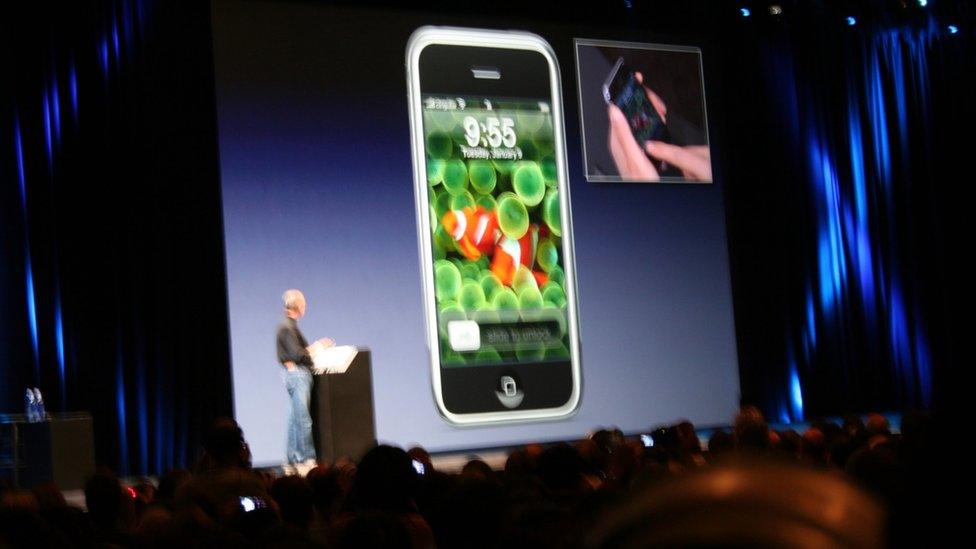iPhone - a moment in history
- Published

Not the greatest shot - but a landmark moment
Ten years ago I was running from San Francisco’s Moscone Centre to a nearby hotel to edit a piece for the Ten O’Clock News when my phone rang.
Those were the days, by the way, when phones were for making calls but all that was about to change.
“Have you got your hands on this new Apple phone for a piece to camera?” shouted a producer in London. “If not, why not?”
This appeared to be an impossible demand.
Steve Jobs had just unveiled, external the iPhone before an adoring crowd but it was not available for grubby hacks to manhandle.
Then I remembered that we had been offered - and turned down for lack of time - an interview with Apple’s marketing chief Phil Schiller. I turned around and headed back to the Moscone Centre. Having located Mr Schiller I asked whether before our interview I might just have a look at the iPhone.
He graciously handed his over - and rather than trying to ring Jony Ive or order 5,000 lattes as Steve Jobs had on stage, I brandished it at the camera for my Ten O’Clock News piece.
The following weekend a Sunday newspaper columnist described me as having clutched the phone as if it were “a fragment of the true cross”, and some viewers complained that the BBC had given undue prominence to a product launch.
I appeared on the Newswatch programme to defend our reporting and said that some products did merit coverage because they promised a step change in the way we lived - and I mused on whether the Model T Ford would have been a story if we’d had a TV news bulletin back then.
Afterwards, I rather regretted saying that - who knew whether the iPhone would really prove as revolutionary as the arrival of mass car ownership?
But today that comparison does not look so outlandish. The smartphone has been the key transformative technology of the last decade, putting powerful computers in the hands of more than two billion people and disrupting all sorts of industries.

We have become accustomed to having a quality camera a hand's reach away
One example is in the photograph at the top of this article. It’s not very good - but then again it was taken by me on a digital SLR camera. In difficult lighting conditions, I struggled to get Steve Jobs in focus on stage.
Compare and contrast with a photo taken 10 years later in Las Vegas last week - it was shot on an iPhone but could just as well been captured on any high-end smartphone such as a Google Pixel, and was the work of the same incompetent photographer.
This 2017 photo could be instantly shared on social media - the Steve Jobs one stayed in my SLR for days.
My point is that the iPhone radically changed the way we thought about photography and a whole range of other activities we could now do on the move.
Of course, there were cameras on phones before 2007, just as there were mobile devices that allowed you to roam the internet or send an email. But the genius of Steve Jobs was to realise that without an attractive user interface many people just couldn’t be bothered to do more with their phones than talk and text.
So, despite my rather British distaste for the hyperbole surrounding the iPhone launch - expressed at the time in a blog - I now look back and feel grateful to have witnessed a moment in history.
Other firms, notably Amazon and Google, are now taking us forward with innovative products imbued with artificial intelligence. But it was on a sunny January morning in San Francisco that the mobile connected era began.
- Published7 January 2017
